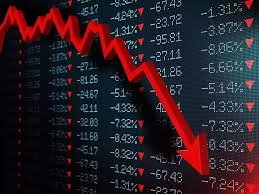Introduction to India’s Stock Market Volatility
The Indian stock market, over the decades, has witnessed multiple periods of extreme volatility, some resulting in severe crashes. These crashes were triggered by a variety of factors ranging from global economic turmoil to financial scams, policy changes, and pandemics. Understanding these events is essential for students preparing for competitive exams, as questions on economic history, market reforms, financial awareness, and economic governance are common in the syllabi.
Major Stock Market Crashes in India
Some of the most notable stock market crashes in India include:
- 1992 Harshad Mehta Scam Crash: This crash was caused by manipulation of stock prices through illegal use of banking funds, resulting in the Sensex crashing by over 2,000 points.
- 2008 Global Financial Crisis: Triggered by the collapse of Lehman Brothers in the US, the Indian markets fell sharply, with the Sensex plunging nearly 60% from its peak.
- 2020 COVID-19 Crash: Due to pandemic-related fears and lockdowns, Indian markets crashed drastically in March 2020, reflecting global investor panic.
- 2021 Adani Group Short Seller Impact: The Hindenburg Research report alleging fraud in Adani Group led to sharp declines in group company stocks, affecting overall market sentiment.
Causes Behind the Crashes
These market collapses had varied causes, such as:
- Financial mismanagement and frauds
- Global economic crises
- Policy changes or poor corporate governance
- Geopolitical tensions or pandemics
Each crash had a unique trigger, but all exposed weaknesses in market oversight, investor behavior, and risk management practices.
Impact on the Indian Economy
Market crashes often led to investor losses, drop in market capitalization, foreign institutional investor withdrawal, and reduced consumer and business confidence. They forced governments and regulators like SEBI to introduce reforms aimed at improving transparency, curbing fraudulent practices, and strengthening investor protection.
Learning and Reforms Post-Crashes
Every major crash was a turning point for India’s regulatory evolution. For instance, the aftermath of the Harshad Mehta scam led to the establishment of SEBI as a powerful regulatory authority. Post-2008, India strengthened financial safeguards and diversified its economy. The 2020 crash emphasized the importance of health emergencies on financial systems and led to a more cautious investment climate.

Why This News is Important
Understanding Financial Market Mechanisms
For students preparing for banking, SSC, teaching, and civil services exams, the stock market is a key topic in economic awareness and general knowledge. Crashes offer insight into the causes of financial instability, importance of regulation, and investor psychology.
Helps in Policy and Reform-Based Exam Questions
Exams like UPSC, State PSCs, and RBI Grade B often ask about economic reforms, regulatory institutions like SEBI, and historical crises that shaped India’s economy. This news covers all these dimensions, making it highly relevant for aspirants across exam categories.
Historical Context: Timeline of Major Crashes in India
Harshad Mehta Scam (1992)
This was the first time India experienced a scam-induced stock market crash. Using fake bank receipts, Mehta pumped money into select stocks, inflating their prices. Once the scam was exposed, the market tumbled, and investors lost crores.
Global Financial Crisis (2008)
The Lehman Brothers’ collapse led to a chain reaction that hit global markets, including India. It exposed the vulnerabilities of interconnected financial systems and prompted major reforms in banking and market regulations worldwide.
COVID-19 Pandemic (2020)
The sudden global lockdown and economic shutdown led to a sharp sell-off, as uncertainty clouded markets. Sensex dropped nearly 40% in weeks before a gradual recovery supported by stimulus and easing measures.
Key Takeaways from “Biggest Stock Market Crashes in India”
| S. No. | Key Takeaway |
|---|---|
| 1 | India has experienced multiple stock market crashes, notably in 1992, 2008, and 2020. |
| 2 | Causes ranged from financial frauds and global crises to pandemics and market manipulation. |
| 3 | Crashes led to major investor losses and impacted economic sentiment and policymaking. |
| 4 | Regulatory changes like strengthening SEBI were introduced after every major crash. |
| 5 | Understanding these events is important for competitive exams covering economics and finance. |
FAQs: Frequently Asked Questions
1. What was the main reason behind the 1992 stock market crash in India?
The 1992 crash was primarily due to the Harshad Mehta scam, where he manipulated stock prices using fraudulent banking practices.
2. How did the 2008 Global Financial Crisis affect India?
The 2008 crisis, caused by the collapse of Lehman Brothers in the US, triggered massive FII withdrawals, a significant drop in Sensex, and impacted investor confidence in India.
3. What role does SEBI play in preventing stock market crashes?
SEBI (Securities and Exchange Board of India) is India’s market regulator, ensuring transparency, preventing fraud, and regulating securities markets to protect investors.
4. How did the COVID-19 pandemic affect the Indian stock market?
In March 2020, due to global lockdowns and economic uncertainties, the Indian market crashed significantly, with the Sensex dropping over 30% in a short period.
5. Why is understanding stock market crashes important for competitive exams?
Stock market crashes are linked to economic policies, governance, reforms, and investor behavior—topics that appear in UPSC, Banking, Railways, SSC, and other government exams under current affairs and economic awareness.
Some Important Current Affairs Links


















 Exciting News!
Exciting News!  Join Our Telegram Channel Now!
Join Our Telegram Channel Now!
 Join our Telegram channel for a thrilling adventure into the world of daily current affairs.
Join our Telegram channel for a thrilling adventure into the world of daily current affairs. 
 Don’t miss out on the latest updates and insights! Click to join now and be part of the knowledge revolution!
Don’t miss out on the latest updates and insights! Click to join now and be part of the knowledge revolution! 
